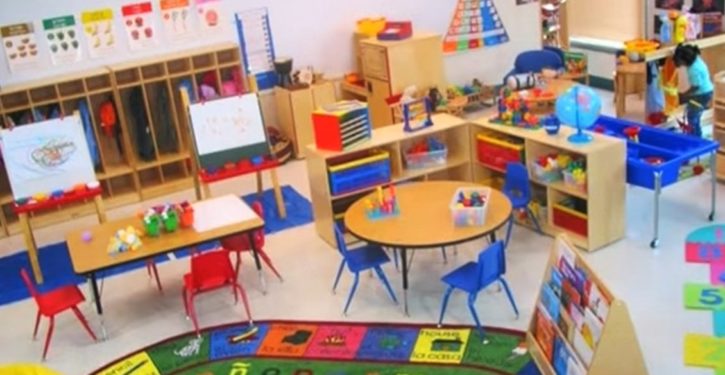
“If the ‘Build Back Better’ plan passes in the most recently published form, virtually every middle-class family will see their childcare costs go through the roof, while severely limiting options,” notes Larry Fine. “The Democrats’ “Build Back Better” proposals for childcare represent a disastrous step in the ongoing government takeover of the sector – raising care costs, creating dependence, and instilling incentives against work and earning more income along the way,” notes economist Ryan Bourne.
As Bourne observes, “Despite a stated goal of making childcare more affordable, the legislation would make it more expensive.” This is because
- eligible providers would have to pay … child-focused care workers …. salaries [comparable] to their state’s elementary school teachers. These provisions would raise costs dramatically in a labor-intensive sector where staff costs can average around 60-70 percent of the total. The average childcare worker nationally is currently paid $25,460, against $60,660 for the average elementary school teacher (in other words, the latter earns 138 percent more).
- to qualify for federal grants, states must also develop licensing regimes “appropriate for childcare providers in a variety of settings.” Past research on childcare licensure, including educational requirements, has found that these also raise costs by restricting the supply of would-be carers, without improving child outcomes.
- state program plans would have to place providers into “quality” tiers, providing resources to achieve “high quality” care for all. In childcare speak, “quality” isn’t about what parents actually want, but criteria defined by government officials, usually meaning low child to staff ratios, extensive educational requirements for staff, and other regulations, all of which tend to raise costs and reduce the availability of care in poor areas (again, without much evidence they improve outcomes for kids or parents).
By piling on these costly mandates, the bill would make childcare more expensive. Although taxpayers would pay for much of it, especially for lower-income households.
If parents earn less than 75 percent of their state’s median income for a family of your size, their childcare costs are wholly paid by taxpayers. As their income rises from 75 percent to 100 percent of their state’s median income, their out-of-pocket copay would rise to a cap of 2 percent of your income. By 125 percent of state median income, that would rise again to 4 percent. It then increases further, so that above 150 percent of median income, out-of-pocket childcare costs would reach a copay of 7 percent of income.
Bourne says this would result in perverse incentives. “On the provider side, it would surely crowd out many alternatives to center-based care…For households, the program creates big disincentives to work or earn more income.”
Take a state where median household income is $55,000 and full-time infant center care for one child costs $10,000. Under the bill:
- a family earning up to $41,250 with an infant would have childcare totally paid for by the taxpayers.
- families with incomes rising from $41,250 to $55,000 would see their contribution rise from $0 to $1,100 (imposing an implicit marginal tax rate increase of 8 percent over this income range).
- families with incomes rising from $55,000 to $68,750 would see childcare costs grow from $1,100 to $2,750 (equivalent to an marginal tax rate increase of 12 percent).
- families with incomes rising from $68,750 to 150 percent of the state median ($82,500) would go from paying $2,750 in childcare per year to $5,755 (a marginal tax rate increase of almost 22 percent).
- at incomes above $82,500, families would face an additional 7 percent marginal tax rate on new income until the household covered the full costs of their childcare out-of-pocket (at around $143,000).
Thus, Bourne notes, “across a wide income range, then, this program would add serious disincentives to earning more income, by raising the effective marginal income tax rate households face. That’s based on the sorts of prices families face for childcare now.” But “prices would likely be much higher” under the economic environment created by the bill. “As a consequence, taxpayer subsidies would both be larger still and the damaging marginal tax rate hikes would ripple much further up the income scale….If all that wasn’t troublesome enough, Matt Bruenig, a supporter of childcare subsidies, has shown that the way the program would be phased in over three years would create even more egregious work incentives in the near-term.”
As Bruenig explains,
in the first 3 years of the program, families with incomes that are just $1 over 100% of the median income (year one), 115% of the median income (year two), or 130% of the median income (year three) will be eligible for zero subsidies, meaning that they will be on the hook for the entire unsubsidized price, which as discussed above will now be at least $13,000 per year higher than before… [note: due to the higher wages to carers the legislation demands providers pay].
…the median household income last year in the country was $67,521. If this was your state’s median income, then having a family income just $1 higher than that would result in you being ineligible for childcare subsidies in 2022 even as the unsubsidized price of child care skyrockets due to the wage and other mandates in the Democratic proposal….
Under this scenario, there will be many dual-earning couples who cannot afford child care if both of them continue to work, but could afford child care if one of them quit their job and thereby brought their family income below the eligibility cutoff. Normally people who quit jobs to take care of their kids do so in order to save the money they’d have to spend on child care. Under this plan, they have to quit their job in order to afford child care!



